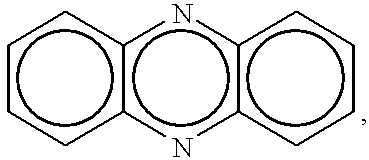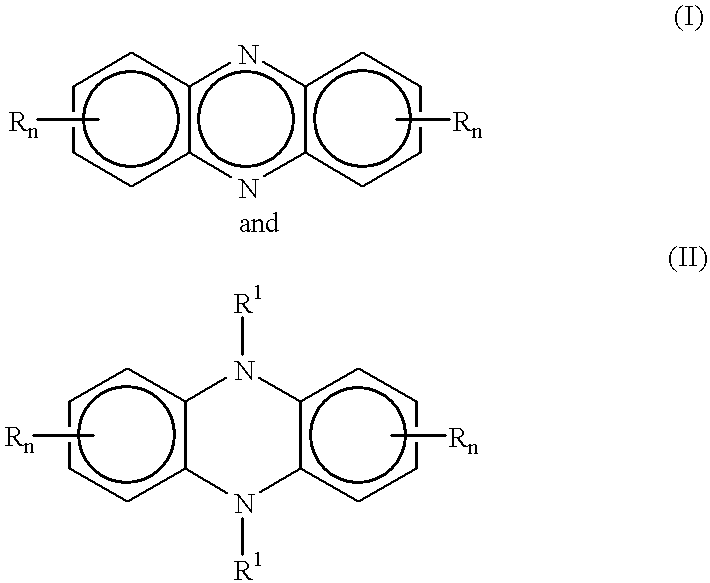One pot synthesis of 5,10-dihydrophenazine compounds and 5,10-substituted dihydrophenazines
a technology of dihydrophenazine and dihydrophenazine, which is applied in the field of low cost method of preparing dihydrophenazine and dihydrophenazine derivatives, can solve the problems of inacceptability of oxirane groups, isocyanate groups, cyanate groups, etc., and achieve the effect of inexpensively prepared in large quantities
- Summary
- Abstract
- Description
- Claims
- Application Information
AI Technical Summary
Benefits of technology
Problems solved by technology
Method used
Image
Examples
example 2
To a 12 L flask is added 800 g of the wet filter cake from Example 1, 3.8 L acetonitrile, 275 g sodium dithionite, 868 g sodium carbonate, 1.2 L methyliodide, and 140 g methyltributylammonium chloride. The reaction is heated overnight to approximately 40-70.degree. C. under reflux. TLC of the reaction mixture of this first run shows the reaction is complete.
In a second run, to a 5 L flask are added the same ingredients as in the preceding paragraph, but in half the amounts previously indicated. Approximately 500 mL acetonitrile is removed by distillation and 2 L water added. The flask is cooled to room temperature overnight.
In both flasks, considerable white inorganic materials are visually present. Each flask contains two layers. Half the organic layer from the first flask is combined with the organic layer in the second flask, and 10 L of deionized water added to each flask and stirred for 45 minutes at room temperature. All inorganic materials dissolve, and the product crystalliz...
example 3
A 100 g sample of 5,10-dihydrophenazine is heated, melted, and sublimed, while a steady stream of oxygen is sparged through the flask. The sublimate is largely phenazine.
example 4
5,10-dihydrophenazine in an amount of 10 g is dissolved in 100 ml ethanol and added to 2.6 g NaOH dissolved in 2 ml of water. The mixture was heated to reflux and O.sub.2 bubbled through for 30 minutes. TLC shows that the 5,10-dihydrophenazine is converted completely to phenazine. The mixture was stripped to a volume of 45 ml and 25 ml water added. After cooling in a refrigerator, 8.0 grams of crude phenazine is collected by filtration. The crude phenazine is dissolved in 80 ml toluene, filtered hot, and stripped to 25 ml. When cooled, 5.86 of still somewhat brown phenazine is collected. After an additional recrystallization from toluene, a further toluene solution (50 ml) is treated with 1.0 g charcoal, reduced to 20 ml, cooled to room temperature and then under refrigeration, to yield 4.0 g (40%) of yellow phenazine.
PUM
 Login to View More
Login to View More Abstract
Description
Claims
Application Information
 Login to View More
Login to View More - R&D
- Intellectual Property
- Life Sciences
- Materials
- Tech Scout
- Unparalleled Data Quality
- Higher Quality Content
- 60% Fewer Hallucinations
Browse by: Latest US Patents, China's latest patents, Technical Efficacy Thesaurus, Application Domain, Technology Topic, Popular Technical Reports.
© 2025 PatSnap. All rights reserved.Legal|Privacy policy|Modern Slavery Act Transparency Statement|Sitemap|About US| Contact US: help@patsnap.com



